Published on March 16, 2023

Discover the 13 French regions

Have you ever asked your French tutor where in France they come from? If you do, you may soon embark on an unexpected journey through l’Hexagone, as the French affectionately call their country in reference to its shape. From north to south and from east to west, each part of France has its own unique features and charm.
The 13 regions and 96 departments of mainland France, plus five overseas departments, make up this patchwork of varied landscapes and cultural wonders. And just as French culture continues to evolve, these regions tend to shift and move with time. A case in point is the question of how many regions are actually in France. There were once 22 regions, but a 2016 effort to reduce cost and bureaucracy united several smaller regions into “super regions.” Without further ado, join us now on our tour of the 13 French regions as they stand today.
In the southeast part of France, Auvergne-Rhône-Alpes is the country’s second most important economic region. This large region includes an incredible variety of landscapes, from the dead volcanoes of Auvergne to the mountains of the Alps. Lyon, its capital and the third city of France, is famous for its gastronomy and its charming old town. Try to plan your visit to Lyon around the city’s renowned festival of lights, held every year on December 8th.
It’s hard to overlook or overrate the illustrious wine country of Burgundy, with its renowned gastronomy and several World Heritage sites. Even outside the vineyards of Burgundy, Bourgogne-Franche-Comté is a region where nature and culture live harmoniously. You can find it in the center-east of France.
In the northwestern part of France, Brittany is famous for its Celtic cultural heritage, which is readily apparent in the quaint villages that dot the region’s coastline. This heritage is probably why the region was chosen as the birthplace of Astérix, the Gallic hero from one of the most beloved French comic strips. The region is also famous for its sweet and savory crêpes (pancakes) and cider.
Located to the south of the region of Paris, the Centre-Val de Loire is most famous for its Loire Valley castles, making it one of the top tourist destinations of France. This wine region is also ideal if you enjoy scenic road trips or bike rides.
Just off mainland France, the mountainous island of Corsica fully deserves its title of île de la beauté (island of beauty). The homeland of Napoleon is a haven for those who enjoy beautiful hikes. Be sure to bring your sturdiest shoes, because trails such as the famed GR20 can be as grueling as they are scenic.
Grand Est shares 800 kilometers of border with four countries (Germany, Belgium, Luxembourg and Switzerland). Add that to the fact that the European Parliament sits in Strasbourg, and it’s fair to say that Grand Est is a key region on the European stage. Come Christmas time, it’s also an ideal destination if you wish to sip mulled wine and sample regional cuisine at some truly magical markets.
The name Hauts-de-France (which could be translated as “High of France”) seems a good choice for what is the northernmost part of the country. With the Eurostar stopping at Lille and the harbor of Calais, the region has direct connections to nearby countries such as the United Kingdom and Belgium.
Île-de-France (which literally means “Island of France”) is the smallest region of mainland France. Even so, it’s one of the most important — be it in terms of French politics, economy or population. This is because it includes the French capital of Paris, which covers nearly 25% of the entire region.
Ever since D-Day took place on its beaches on June 6th, 1944, the region of Normandie (Normandy, in English) has been inseparable from World War II. Perhaps unsurprisingly, much of the region’s tourism revolves around locations that played a key role in this dark period of history. But this agricultural region also offers plenty of other opportunities for green tourism — not to mention a coastline studded with white-chalk cliffs.
Not content with being the largest region in all of France (and a very dynamic one economically), Nouvelle-Aquitaine has a few other tricks up its sleeve. For example, the world-famous vineyards of Bordeaux and Cognac. At the region’s southernmost end, you’ll find France’s shared border with Spain.
The second largest region of mainland France comprises a number of landscapes that vary in their terrain, if not in their degree of beauty. Whatever your speed, you’ll find it here — from the beaches of the Mediterranean sea to the Pyrenees mountains to the scenic countryside. Highlights include the Canal du Midi as well as the thriving cities of Toulouse and Montpellier.
Sitting on the west coast, next to Centre-Val de Loire, this region also owes its name to the Loire, the river that crosses it. The Pays de la Loire (“Lands of the Loire”) is also home to several beautiful Loire Valley castles, even though they may have gained less international fame than their neighbors from Centre-Val de Loire.
Home to the French Riviera and with a rich landscape of beaches, mountains and villages hanging on rolling hills, Provence-Alpes-Côte d’Azur is one of the top tourist destinations in France. Its position on the Mediterranean sea, with Italy to the east and Africa just across the sea, makes it a huge hub. The region is at the forefront of innovation, as exemplified by Sophia-Antipolis, the largest technology park in Europe.
This tour of the 13 French regions should give you a taste of the large variety of magnificent landscapes, cultural highlights and culinary delights that make France one of the top tourist destinations in the world. It may even boost your motivation to learn French!